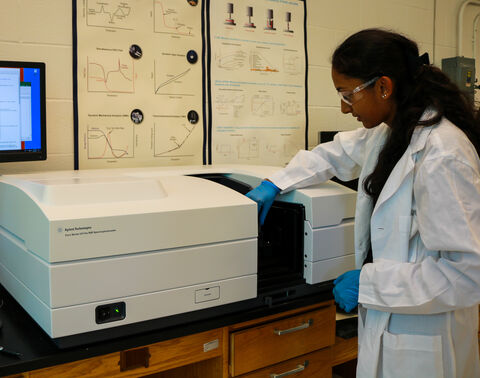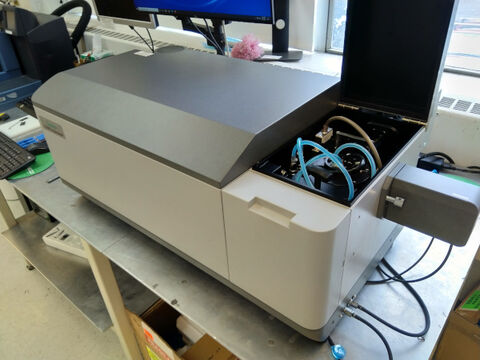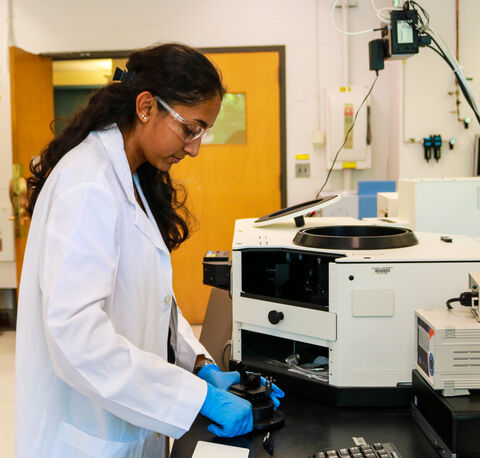Optical Spectroscopy
Cary 5000 UV-Vis-NIR Spectrophotometer
Bard Hall B56 (Primary Staff: Mark Pfeifer; Secondary Staff: Kevin Silverstein)
The Cary 5000 is a high performance UV/Vis/NIR optical spectrophotometer, capable of measuring spectra in the range of 175-3300 nm. Spectra can be acquired in transmission, diffuse reflectance and total reflectance. The system can accommodate a wide range of sample types including liquids, suspensions, solids and films. Sample sizes can vary from 140 mm to as small as 1 mm. Acquisition areas range from 10 mm diameter to 1 mm diameter. Some common applications are: film and antireflective coating analysis; color measurement and matching; and optical density analysis. Instrument specs are below:
- Detectors: Scintillating from 175nm-800nm; PbS from 800nm-3300nm
- Optics: Schwarzschild coupling
- Sources: Standard tungsten quartz: 350nm-3300nm; deuterium: 350nm-175nm
- Energy discrimination: Double out-of-plane Littrow monochromator
- Range of spectral band width: UV: 0.01nm-5nm; NIR: 0.04nm-20nm
- Cary 5000 website
JASCO-1500 CD Spectrometer
Bard Hall B56 (Primary Staff: Mark Pfeifer; Secondary Staff: Kevin Silverstein)
The JASCO J-1500 measures the relative transmission of left and right circularly polarized light in the 163-950 nm spectral range. Circular dichroism is used to characterize chiral molecules, particularly the secondary and tertiary structure of proteins. This instrument includes a thermoelectrically heated and cooled sample turret for efficient measurement of multiple samples as a function of temperature. The spectrometer can be programmed to cycle through up to 6 samples, measuring circular and linear dichroism at either single wavelength or as full spectra at each temperature in a profile.
Instrument specifications are below:
- Source: Xe lamp with nitrogen purging.
- Energy discrimination: Double prism monochromator.
- Sample holder: 1 mm (with spacer) to 10 mm path length quartz cuvettes for liquids. Thin solids possible.
- Temperature control: 6 position turreted thermoelectrically controlled sample environment, -40 to 130 °C.
- JASCO J-1500 website
Edinburgh FLS1000 Spectrometer and Lifetime Measurement
Bard Hall B56 (Primary Staff: Mark Pfeifer; Secondary Staff: Kevin Silverstein)
The Edinburgh FLS1000 Spectrometer can be used for near-IR to near-UV fluorescence spectroscopy. Using a white light source, spectrographic measurements can be made by sweeping the excitation monochromator, exit monochromator, or both in a 2D spectrum map. Using pulsed sources (laser diode or LED) electronically synchronized with the detector, fixed wavelength lifetime measurements can be made from milliseconds down to one nanosecond. Typical samples are liquids in a cuvette, although measurements on powders or surfaces are possible.
- Excitation Sources:
- Ozone-free Xenon arc lamp (230 nm – 1000 nm)
- Pulsed laser diodes (405 nm, 450 nm)
- Pulsed LED (280 nm)
- Optics:
- Excitation and emission monochromators
- Excitation and emission variable polarization filters
- Variable attenuation disk
- Integrating sphere for quantum yield measurements
- Detector:
- Photon counting photomultiplier tube
- Accessories:
- Temperature controller and thermoelectrically heated/cooled cuvette holder
- Links: Documentation can be found in FOM under ‘Documents'.





